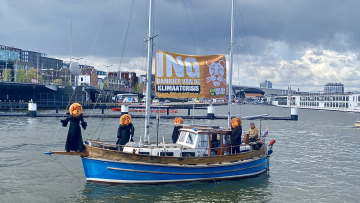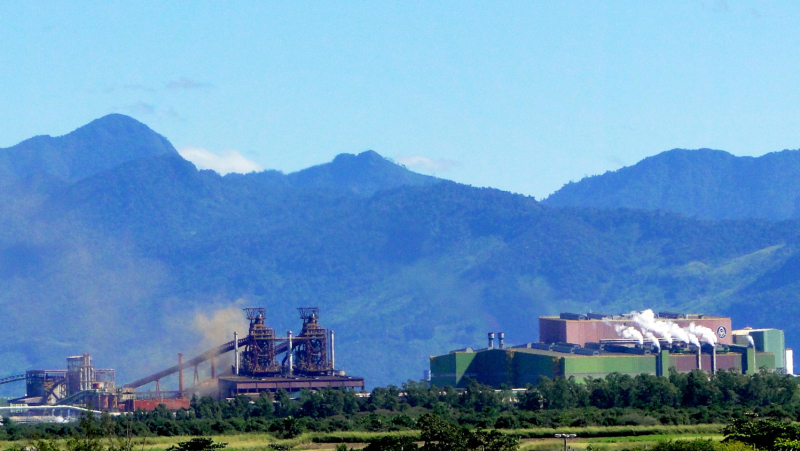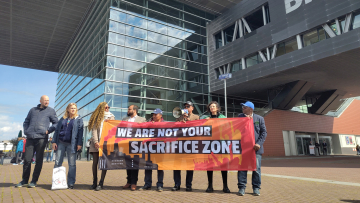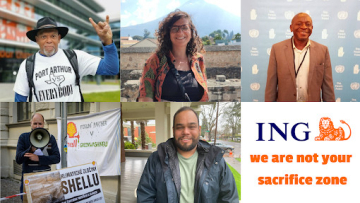
Company – On record
This profile is no longer actively maintained, with the information now possibly out of dateJulia Hovenier, BankTrack

Company – On record
This profile is no longer actively maintained, with the information now possibly out of dateJulia Hovenier, BankTrack
Why this profile?
Environmental and Indigenous defenders opposing Ternium’s iron ore mine in Mexico are facing unacceptable threats of violence, disappearances, and homicides. Additionally, Ternium’s steel making operations in Mexico, Brazil, and Argentina disproportionally present unacceptable risks to Black and Brown communities living near its facilities which pose a dangerous threat to the climate, and public health through the pollution of water, soil, and air.
What must happen
We echo the demands of Mexican human rights defenders, and call for banks to suspend their relationships with Ternium until the rights and safety of environmental defenders is guaranteed, and reparations are paid to Indigenous survivors of violence in Mexico.
Banks with exposure to Ternium must ensure that none of their financing supports the Peña Colorada and the Aquila mines until Mexican federal authorities have conducted a thorough investigation of the disappearances and killing of three environmental defenders, and Ternium conducts its internal investigation on the alleged role of the Aquila executives, with enhanced due diligence standards. Banks should instead seek opportunities to finance fossil-free steel production to help meet the world's steel needs in a clean and rights-compatible manner.
| Sectors | Iron and Steel Manufacturing , Mining |
| Headquarters |
|
| Ownership |
listed on NYSE
The Rocca Family are the largest shareholders, and own 65.03% of the shares |
| Subsidiaries |
|
| Website | https://www.ternium.com/en |
Ternium is a Luxembourg-based company and one of the largest steel producers in the Americas. In 2022 it emitted 18.6 million tonnes of CO2 and sold close to 12 million tonnes of steel. It currently operates eight steel plants in Argentina, Brazil, and Mexico, and at least 60% of its production capacity is reliant on coal-consuming blast furnaces. In addition to steel production, Ternium operates three open pit iron ore mines, one of which, the Peña Colorada mine, is a joint partnership with ArcelorMittal. Despite its decarbonisation goal, Ternium is still extending the lifetime of coal-based blast furnaces, meaning it is locking itself into using coal for steelmaking for another 17+ years.
Impact on human rights and communities
Deaths and disappearances of human rights defenders and local activists There have been several cases of disappearances and murders of human rights defenders and local activists opposing Terniums operations. In 2023 alone, in the Jalisco and Michoacán region four human rights defenders, by the names of Ricardo Lagunes, Antonio Díaz, Eustacio Alcalá and Higino Trinidad were disappeared and or killed. All four were involved in legal battles to promote land rights for Indigenous and local communities. The UN, the Inter-American Commission on Human Rights, and human rights organisations across the globe have all called for justice following the disappearances.
Health Impacts of Pollution There are countless reports of harmful health impacts linked to pollution from Ternium facilities. Complaints have been raised by Brazilian lawmakers and confirmed by an independent study. Around its plants in Nuevo León in Mexico, neighbours and around 90.000 university students are exposed to air pollution from its activities. Impacts include allergic reactions, skin and body irritations to pneumoconiosis and cancer. Reports from July 2023 show that many toxic emissions are still increasing. In Argentina there are ongoing lawsuits against Ternium for violating public health and toxic waste disposal laws. Allegations include severe health impacts for residents including the death of a six-month old child.
Threatening indigenous livelihoods In multiple cases Ternium has been accused of “Water Looting”, meaning it depletes local water reserves for industrial use. The overexploitation of wells caused the disappearance of the Prieto River in Mexico. The water reserves of Monterrey in Nuevo León, location where it operates multiple facilities, were expected to last only two more months and Monterry suffered “the largest water crisis in the history of Mexico” in 2022. Mexico City is expected to lack sufficient water reserves to meet basic needs by the end of 2024 due to water looting by Ternium and other industrial activity. Additionally, the contamination and depletion of wells has had a severe impact on agricultural activities as intoxicated water has contaminated crops.
Non-compliance with agreements with local communities There are several documented cases of Ternium not fulfilling promises made to communities in order for them to approve industrial activities. These include not following up on payment promises and deliberately expanding mining operations resulting in land grabbing and the disregard of elementary indigenous rights. This is an ongoing struggle in the region since mining activities started.
Fueling societal division and unrest Since Ternium began its iron ore mining operations in Mexico, social unrest, division and violence has increased. The company is accused by frontline communities of following a strategy of community division. This manifests in the case of an alleged murder within the community, allegedly due to disagreements regarding mining operations. While Ternium has publicly denied any role in the disappearances of defenders Ricardo Lagunes Gasca and Antonio Díaz Valencia, in its annual reports the corporation has acknowledged disputes with the indigenous community, blaming it to the “high level of criminality” in the mining region. Due to its profitability, Ternium’s mining activities have attracted organised crime causing a general threat and climate of violence for affected communities. In Brazil there is a long history of struggle of residents holding Ternium accountable for impacts on their lives.
Fatal and unsafe working conditions In 2013, 11 workers died in a Ternium mine in Mexico. Employees reported a dangerous working environment with high levels of pollution, leakages of gas, old machinery and poor maintenance. In 2017, an OECD complaint was filed in Guatemala by the IndustriAll Global Union. The complaint stated that Ternium had threatened workers who denounced bad working conditions, tried to prevent unionisation efforts, fired pro-union workers, and denied paid leave to union activists creating a “climate of terror”. It took three more years until the company agreed to sign a collective employment agreement. In 2018, a 29 year old engineer died in Terniums Planta Ensenada in Argentina. Commenting on the tragedy, workers reported repeated accidents in the factory, and the company’s historic underinvestment in worker health and safety.
Impact on climate
Locking in coal for steel In 2022, Ternium announced its decision to invest around USD 270 million in relining projects to extend the lifetime of two of its Brazilian coal-based steel making facilities. At a maximum annual capacity of 2.5 million tonnes of steel, resulting emissions are estimated to be 5.825 million tonnes of CO2 annually. Relinings enable an estimated 17 more years of burning coal, which could mean the investment would be associated with 99 million tonnes of CO2, more than the 2021 emissions of countries such as Belgium and Qatar. Blast furnaces, which burn coal and iron ore together in the steelmaking process, are the most carbon-intensive steel making technology. If the world is to meet its target of limiting warming to 1.5ºC, blast furnaces must be phased out as quickly as possible. Relining the dirtiest steel making capacities leaves serious questions to decarbonization efforts with regards to high emissions and carbon-lock in effects that come with them.
Fueling the climate crisis According to the Global Steel Plant Tracker, over 70% of Ternium’s production capacity for iron and over 60% of its steel production capacity is reliant on coal, a major climate killer. In the beginning of 2021 Ternium set a target to reduce its average emissions intensity by 20% by 2030. In the same year its CO2 emissions increased by over 12% compared to the previous year. As an essential part of its decarbonisation strategy it refers to the increase of renewable energy. Currently the share of renewables in the company’s energy mix is stagnant at 0.1% while the share of coal has increased by 6% and for gas by around 3% from 2021. Ternium calculates its overall CO2 emissions (including scope 3 emissions) in 2022 to 18.6 million tonnes of CO2.
Reliant on unproven net-zero technology Ternium plans to achieve its decarbonisation goals with carbon capture usage and storage (CCUS) and biomass. CCUS is not the solution to decarbonising the steel sector. Instead of a history of success, CCUS has so far not worked at scale, while being very expensive. Using CCUS for the steel industry has been criticised by experts who fear that it will perpetuate upstream emissions from coal mine methane. The large-scale use of biomass comes with several problems of its own, like putting further pressure on exploitation of natural resources and having only minimal mitigation effects. Relying on yet unproven and heavily doubted technologies whilst still investing in carbon-intensive processes further increases the potential for carbon effects of carbon lock-in and poses serious doubts about Ternium’s emissions reduction plans.
Impact on nature and environment
Pollution, destruction of flora and fauna, ecocide Ternium’s open pit mining operations in Mexico are causing critical damage to the environment including the diversion and contamination of bodies of water, the devastation of mountain and jungle ecosystems, both of which lead to the disappearance of local flora and fauna. The affected communities accuse Ternium of not taking responsibility. Waste deposits created by mining activities have led to deforestation and degradation of soil in ecosystems that are already fragile. Overall, the mining operations of Ternium are intransparent, making compliance with environmental issues very hard to assess. In Mexico, Ternium was taken to court for its failure to comply with environmental law, resulting in fines. In Argentina, a judicial expert reported massive environmental damages like the contamination of ground water with heavy metals, excessive and illegal exploitation of water, waste spillings and general non-compliance with social and environmental responsibilities. As of November 2023, Ternium is currently facing lawsuits in Argentina for ecocide, river pollution and the resulting health impacts for locals, but is continuing its operations there without permission.
In 2013, Ternium’s subsidiary in Mexico received a USD 800 million five-year syndicated corporate loan arranged by Crédit Agricole CIB, HSBC Bank USA, Bank of Tokyo-Mitsubishi UFJ, and Natixis Global Asset Management as the leaders of a syndicate of 11 financial institutions in total. This was planned to be used to buy stakes in the Brazilian steel producer Usinas Siderurgicas de Minas Gerais SA.
In 2017, Ternium received a USD 1.5 billion dollar five-year syndicated corporate loan from Citigroup Global Markets Inc., Intesa Sanpaolo S.p.A., JPMorgan Chase Bank, N.A., Natixis, The Bank of Tokyo-Mitsubishi UFJ, Ltd., Bank of America, N.A., BNP Paribas, Credit Agricole Corporate and Investment Bank, as well as HSBC Bank USA, N.A., as joint bookrunners. This loan was used in order to acquire the Brazilian steel mill of ThyssenKrupp.
In 2018 and 2019, Ternium borrowed USD 1 billion and USD 500 million five-year syndicated corporate loans for its subsidiaries in Mexico and Argentina, facilitated by an unknown syndicate of banks and financial institutions. The 2019 loan matures in August 2024.
In 2024 Ternium is planning capital expenditures of USD 1.5 billion.
Social Responsibility: The case of Ternium in Santa Cruz
By PACS Brazil
Climate change and steelmaking: Local and global impacts of Ternium Brasil
by PACs Brazil & Fórum Mudanças Climáticas e Justiça Socioambiental
2023
2023-11-28 00:00:00 | Another Indigenous human rights defender kidnapped and killed
The tragic and most recent example of the severe violence that is associated with activities surrounding the Peña Colorada iron ore mine is the death of another local human rights defender. The well-respected community activist and member of the local Inidiginious city council Higino Trinidad de la Cruz was first kidnapped and was found shot dead one day later. This incident is in line with a previous attack against the human rights defender, who had already been kidnapped in 2022. It further contributes to a long history of violence and indiginious rights abuses that came with mining activities in the region.
2023-02-25 00:00:00 | Ternium to build sizeable Electric Arc Furnace mill in Mexico
Ternium announced it will be investing US$1.94 billion to expand it's industrial center in Pesqueria, Nuevo Leon, Northern Mexico.


